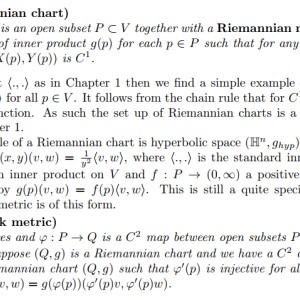How to show that the composition of two riemannian isometries is an isometry?
If for Riemannian charts $(P, g)$, $(Q, h)$ and $(R, i)$ I have two Riemannian isometries (differentiable bijection with differentiable inverse), one $\phi: (P, g) \to (Q,h)$ such that $g = \phi^{*}h$ and one $\rho: (Q,h) \to (R, i)$ such that $h = \rho^{*}i$, how do I show that the composition of these two isometries is again an isometry?
See the file/image for more information on the used notation here.
Answer
Answers can only be viewed under the following conditions:
- The questioner was satisfied with and accepted the answer, or
- The answer was evaluated as being 100% correct by the judge.
1 Attachment
4.8K
-
Thank you Philip! It really helps a lot:). I will consider that indeed, it was my first time using this website so I was not sure what to expect
-
I am glad I was able to help.
The answer is accepted.
Join Matchmaticians Affiliate Marketing
Program to earn up to a 50% commission on every question that your affiliated users ask or answer.
- answered
- 1409 views
- $5.00
Related Questions
- A trigonometry question
- Similar shapes
- How to recalculate 2D polygon side lengths when tilt is applied in 3D space?
- Sibling Triangle Pairs
- Find the Curvature of Parabolic Wave
- Find the area of the shaded region
- Can enough pizza dough be made to cover the surface of the earth?
- Determine formula to calculate the radii of a unique ellipsoid from coordinates of non-coplanar locii on its surface, and without knowing its center or rotation angles.

